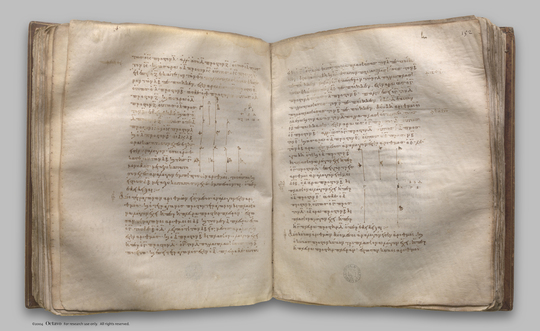index prev next | digilib folio 156

Between two square numbers there is one mean proportional number, and the square has to the square the ratio duplicate of that which the side has to the side.
| Δύο τετραγώνων ἀριθμῶν εἷς μέσος ἀνάλογόν ἐστιν ἀριθμός, καὶ ὁ τετράγωνος πρὸς τὸν τετράγωνον διπλασίονα λόγον ἔχει ἤπερ ἡ πλευρὰ πρὸς τὴν πλευράν. Ἔστωσαν τετράγωνοι ἀριθμοὶ οἱ Α, Β, καὶ τοῦ μὲν Α πλευρὰ ἔστω ὁ Γ, τοῦ δὲ Β ὁ Δ: λέγω, ὅτι τῶν Α, Β εἷς μέσος ἀνάλογόν ἐστιν ἀριθμός, καὶ ὁ Α πρὸς τὸν Β διπλασίονα λόγον ἔχει ἤπερ ὁ Γ πρὸς τὸν Δ. Ὁ Γ γὰρ τὸν Δ πολλαπλασιάσας τὸν Ε ποιείτω. καὶ ἐπεὶ τετράγωνός ἐστιν ὁ Α, πλευρὰ δὲ αὐτοῦ ἐστιν ὁ Γ, ὁ Γ ἄρα ἑαυτὸν πολλαπλασιάσας τὸν Α πεποίηκεν. διὰ τὰ αὐτὰ δὴ καὶ ὁ Δ ἑαυτὸν πολλαπλασιάσας τὸν Β πεποίηκεν. ἐπεὶ οὖν ὁ Γ ἑκάτερον τῶν Γ, Δ πολλαπλασιάσας ἑκάτερον τῶν Α, Ε πεποίηκεν, ἔστιν ἄρα ὡς ὁ Γ πρὸς τὸν Δ, οὕτως ὁ Α πρὸς τὸν Ε. διὰ τὰ αὐτὰ δὴ καὶ ὡς ὁ Γ πρὸς τὸν Δ, οὕτως ὁ Ε πρὸς τὸν Β. καὶ ὡς ἄρα ὁ Α πρὸς τὸν Ε, οὕτως ὁ Ε πρὸς τὸν Β. τῶν Α, Β ἄρα εἷς μέσος ἀνάλογόν ἐστιν ἀριθμός. Λέγω δή, ὅτι καὶ ὁ Α πρὸς τὸν Β διπλασίονα λόγον ἔχει ἤπερ ὁ Γ πρὸς τὸν Δ. ἐπεὶ γὰρ τρεῖς ἀριθμοὶ ἀνάλογόν εἰσιν οἱ Α, Ε, Β, ὁ Α ἄρα πρὸς τὸν Β διπλασίονα λόγον ἔχει ἤπερ ὁ Α πρὸς τὸν Ε. ὡς δὲ ὁ Α πρὸς τὸν Ε, οὕτως ὁ Γ πρὸς τὸν Δ. ὁ Α ἄρα πρὸς τὸν Β διπλασίονα λόγον ἔχει ἤπερ ἡ Γ πλευρὰ πρὸς τὴν Δ: ὅπερ ἔδει δεῖξαι. | Between two square numbers there is one mean proportional number, and the square has to the square the ratio duplicate of that which the side has to the side. Let A, B be square numbers, and let C be the side of A, and D of B; I say that between A, B there is one mean proportional number, and A has to B the ratio duplicate of that which C has to D. For let C by multiplying D make E. Now, since A is a square and C is its side, therefore C by multiplying itself has made A. For the same reason also D by multiplying itself has made B. Since then C by multiplying the numbers C, D has made A, E respectively, therefore, as C is to D, so is A to E. [VII. 17] For the same reason also, as C is to D, so is E to B. [VII. 18] Therefore also, as A is to E, so is E to B. Therefore between A, B there is one mean proportional number. I say next that A also has to B the ratio duplicate of that which C has to D. For, since A, E, B are three numbers in proportion, therefore A has to B the ratio duplicate of that which A has to E. [V. Def. 9] But, as A is to E, so is C to D. |